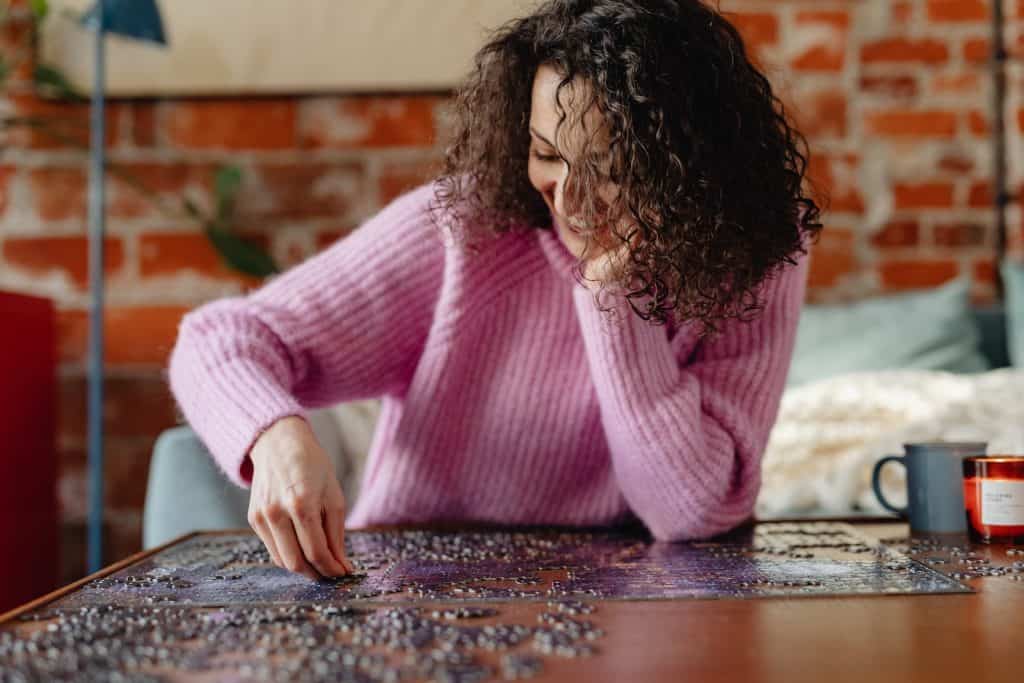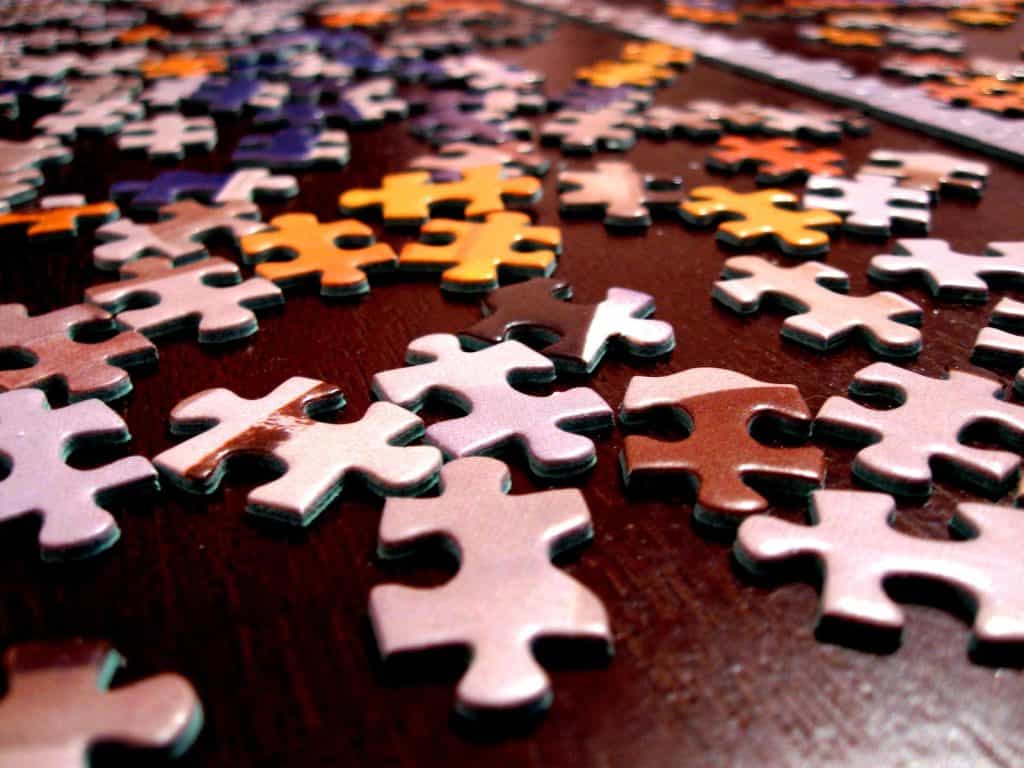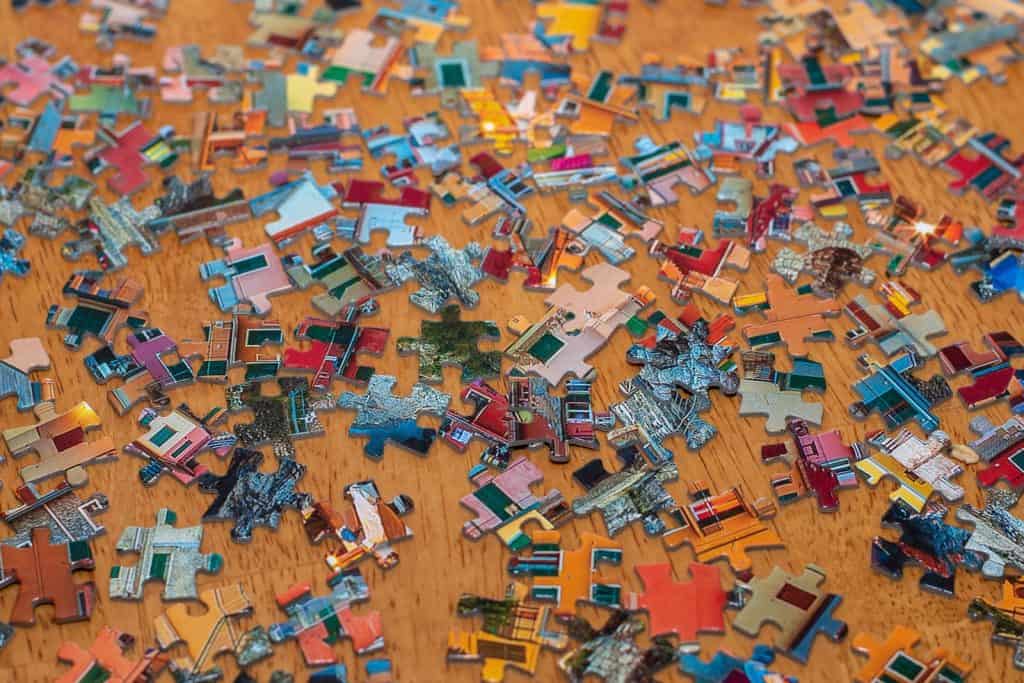Sorting jigsaw puzzle pieces can be a key step toward making the puzzling process more enjoyable and efficient. By taking some time to organize the pieces, you’ll be better able to focus on the fun of assembling the puzzle itself. From edge pieces to centerpieces, following a few helpful tips can make a difference in how you approach a big jigsaw puzzle challenge.
To start, find a low-traffic area with good lighting and ample space, like the dining room table or a puzzle board, to spread out your puzzle. This way, you’ll not only have a large enough flat surface, you’ll also avoid any disturbances or clutter. Your next step is to sort your puzzle pieces into separate categories. Most puzzles have pieces with straight sides, which indicate all the edge pieces. These are essential in forming the frame of your jigsaw puzzle, so make sure to gather all of them in a pile together. From there, you can also sort by color, pattern, and shape, aiming to create small clusters of pieces that seem to go together.
Another technique to make sorting even smoother is to use sorting trays to separate your pieces. These trays can be a great tool for puzzle lovers, as they provide an easy means to keep different shades and shapes of pieces apart during the entire process. Once you have your piles organized and your edge pieces assembled, you can start working on the whole puzzle, piecing together the challenging middle sections while enjoying the fruits of a well-organized puzzling experience.
The Benefits of Sorting Jigsaw Puzzle Pieces

When you dive into a new jigsaw puzzle, you might be eager to start assembling the pieces right away. However, taking the time to sort your puzzle pieces can greatly improve your puzzling experience. Here are some significant benefits of sorting jigsaw puzzle pieces before diving into the assembly process:
- Save time: Sorting the pieces beforehand helps you locate specific pieces much faster when you start assembling your puzzle. By having edge pieces, different shades, and shapes organized, you’ll be able to create a mental map of your jigsaw puzzle and complete it more efficiently.
- Organize your workspace: Sorting jigsaw puzzle pieces helps you maintain a clutter-free and organized puzzle board or surface (like your dining room table). This is crucial for puzzle lovers who want to enjoy a smooth puzzling experience without getting overwhelmed by a mess of pieces.
- Reduces frustration: By having everything categorized into sorting trays, you’ll find it much easier to locate the piece you need without spending hours searching for it. You won’t find yourself stuck at any given point in the process, making it a more enjoyable and satisfying experience.
- Simplifies the process: If you’re dealing with a particularly large or hard puzzle, separating and organizing the pieces will help break the daunting task into manageable, small sections. By focusing on finishing sections one by one, you’ll feel more accomplished and motivated to complete the whole puzzle. Some popular sorting techniques include separating:
- Border pieces from centerpieces
- Pieces by color or pattern
- Pieces with straight sides (part of the edge) from those without (most puzzles)
To make sorting easier, invest in some useful tools, such as sorting trays, a puzzle mat, or even makeshift containers like plastic sandwich bags or empty, shallow boxes. Ensure you have a flat surface that’s in a low-traffic area, has good lighting, and offers a large enough space to spread out your puzzle pieces.
Jigsaw puzzles can be an enjoyable and challenging pastime for puzzle lovers of all ages. By sorting your puzzle pieces before you begin assembling, you’ll create a more enjoyable and streamlined experience, ultimately leading to a beautifully completed jigsaw puzzle. So the next time you’re ready to tackle that new puzzle, take a moment to sort and organize the pieces first. You’ll thank yourself later!
Developing a Sorting Strategy for Puzzle Pieces

When it comes to sorting jigsaw puzzle pieces, having a solid strategy can make the whole process more enjoyable and help you complete your masterpiece more efficiently. Here are some useful tips to develop a sorting strategy that works for you.
Firstly, choose a location with good lighting and a flat surface large enough for your jigsaw puzzle and all its pieces. A low-traffic area such as a dining room table can be a great choice, as it reduces the risk of pieces getting lost or moved. A puzzle board or puzzle mat can also be helpful for keeping the workspace organized and protecting the table surface.
Once you’ve picked the ideal location, gather some sorting trays or plastic containers to store the different piles of puzzle pieces. This will keep the pieces from spreading across your table and make it easier to sort your puzzle pieces into relevant categories.
Start by separating the edge pieces from the centerpieces, as they are essential in creating the frame of your puzzle. Most puzzles have border pieces with straight sides, so they’ll be easy to identify. Assemble the frame first on the table or on your puzzle board, as it helps define the workspace for the rest of the puzzle.
Next, sort the centerpieces based on the following characteristics:
- Colors and patterns: Group pieces with similar colors, patterns, and textures together. This will make it easier to identify and assemble small clusters when working on the puzzle.
- Shape and connectors: Jigsaw puzzles come in a variety of shapes. Some puzzle lovers like to sort their pieces by the shape of the connectors, creating piles of pieces with similar shapes to make them easier to find during assembling.
Once the pieces are sorted, it’s time to tackle your puzzle. Work on smaller sections with similar colors or patterns, and then move on to other areas. As you complete these sections, connect them to the border pieces, gradually filling in the gaps of your masterpiece.
The key to an efficient sorting strategy lies in staying organized and working methodically through your piles. Here’s a quick recap of the steps:
- Choose a location with good lighting and a flat surface.
- Use sorting trays to separate your pieces by categories.
- Assemble the frame first, using all the edge pieces.
- Sort the centerpieces by colors, patterns, and shapes.
- Work on smaller sections of the puzzle before connecting them to the frame.
By following these tips, you’ll develop a sorting strategy that suits your style and helps you enjoy your jigsaw puzzles to the fullest.
Useful Tools in Sorting and Organizing Pieces
Sorting jigsaw puzzle pieces can be a tedious task, but it’s essential for an enjoyable and organized puzzle-solving experience. Here are some useful tools and tips to help you sort and organize your pieces efficiently.

Puzzle Board: Using a puzzle board as your workspace offers the perfect, flat surface for sorting and assembling your jigsaw puzzle. Instead of occupying your dining room table, investing in a dedicated puzzle board ensures a clutter-free and easily accessible space designed for puzzling. Make sure it has good lighting and is in a low-traffic area in your home.
Sorting Trays: Sorting trays come in handy for organizing pieces by different factors such as color, pattern, or shape. From all the edge pieces to centerpieces and other specific parts, having multiple sorting trays can keep all the pieces separated and ready for use. This will help you assemble puzzles quicker, as you can easily spot the right piece when needed.
Puzzle Mat: A puzzle mat is another useful tool for jigsaw puzzle lovers. It’s a flexible, roll-up surface for your puzzle, enabling you to save your progress and store the whole puzzle away without fear of losing pieces or breaking completed sections. With a puzzle mat, you won’t need a dedicated, large enough space to leave your puzzle out for days on end.
In addition to these tools, some tips can help you sort your puzzle pieces more effectively:
- Sort by edges and straight sides: By separating border pieces from the rest, you create the frame of your picture first, which makes it easier to fill in the middle section later on.
- Organize by color and pattern: Grouping similar colors or patterns (for example, different shades of blue) into a single tray or piles not only helps you find pieces faster but also lets you focus on small sections or clusters of the puzzle at a time.
- Arrange based on shape: Since the shape of a puzzle piece can act as a clue to where it belongs, organizing pieces by shape can help you solve a hard puzzle.
Jigsaw puzzles can be fun and challenging, but staying organized is crucial for a smooth puzzling experience. Having a dedicated workspace and investing in tools like puzzle boards, sorting trays, and puzzle mats will set you up for success. Armed with these tools and tips, you can confidently tackle even the most challenging jigsaw puzzles and enjoy hours of puzzling fun!
Common Sorting Methods for Efficient Puzzle Solving
Sorting jigsaw puzzle pieces can be a game changer when it comes to assembling your favorite puzzle. Having a well-organized system not only helps you find the right piece when you need it but also makes the whole process more enjoyable. Here are some common sorting methods that’ll help you tackle your next jigsaw puzzle with ease:
- Sort by edge pieces and centerpieces: This is probably the most widely-used method among puzzle lovers. To start, separate all the edge pieces from the centerpieces. This will help you establish the border of your puzzle early on, giving you a foundation to work from. Edge pieces are easy to identify, as they’ll have one or two straight sides.
- Sort by shape: While working on a puzzle, you’ll notice that there are various shapes among the puzzle pieces. Grouping pieces based on their shape can save you time when trying to connect them. For example, pieces with a flat surface on both sides can be gathered together, making it easier to find the suitable match.
- Sort by color: Collecting puzzle pieces with similar colors together can make it easier to focus on constructing small sections of the puzzle. Since most puzzles feature different shades and patterns, sorting by color helps you create small clusters of related pieces to work with.
To make your puzzle-solving experience even more seamless, consider the following tips:
- Select an appropriate workspace: Choose a large enough space like a dining room table or a puzzle board. Make sure it has good lighting and is a low-traffic area to avoid potential disruptions. A puzzle mat can be used to protect your work area and provide a flat surface to work on.
- Use sorting trays: Sorting trays come in handy when organizing your jigsaw puzzle pieces. They help to reduce clutter and make it easy to see all the pieces at once. You can even use household items such as small cardboard boxes or plastic containers as makeshift sorting trays.
- Assemble the frame first: Once you’ve sorted all the edge pieces, begin assembling the outer border. This will give you a clear idea of where the rest of the pieces fit within the puzzle, making it easier to complete the center portion.
Remember, the key to efficiently solving a jigsaw puzzle is keeping your workspace organized and having a clear plan of action. By incorporating these sorting methods and tips, you’ll be well on your way to completing even the most challenging puzzles in no time. Happy puzzling!
Conclusion: Enhancing Your Jigsaw Puzzle Experience
Sorting jigsaw puzzle pieces can make a significant difference in how you approach and accomplish your puzzle-solving endeavors. By applying the tips and tricks mentioned throughout this article, you’ll undoubtedly enhance your jigsaw puzzle experience and increase your chances of completing even the most challenging puzzles.
Start with sorting trays to keep your puzzle pieces organized and easily accessible. Focus on separating edge pieces, center pieces, and different shapes, making it easier to put together the puzzle frame and fill in the center. Setting up a clean and spacious puzzle board or dedicating a low traffic area like a dining room table is also beneficial. Invest in a puzzle mat if you need to save your work and free up space occasionally. After all, good lighting and a comfortable workspace make a difference in the fun and satisfaction that comes with completing a puzzle.
Remember to use a systematic approach when solving your puzzle:
- Sort your puzzle pieces by color, pattern, and shape
- Assemble the frame using edge pieces with straight sides
- Use clues from the box and puzzle piece shapes to create small clusters of completed sections
- Move on to larger sections until the whole puzzle comes together
As you work on jigsaw puzzles, keep in mind that every puzzle is unique, so be prepared to tackle a variety of challenges. Stay patient and enjoy the journey toward completing your masterpiece. By embracing these puzzle-solving ideas and maintaining organized puzzle pieces, you can transform a seemingly hard puzzle into an enjoyable pastime that brings relaxation, mental stimulation, and a sense of accomplishment.
In conclusion, it’s essential to remember that jigsaw puzzles are meant to be a pleasurable and engaging activity. Don’t hesitate to experiment and find the best methods for your individual puzzle-solving style. With a bit of persistence and organization, you’ll become a more skilled and confident puzzler, ready to tackle the next challenge that awaits you.

